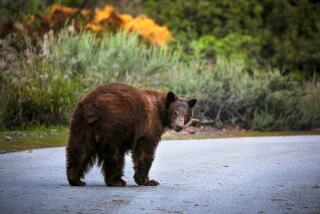Deer Farmers Hope for Big Bucks in Venison
- Share via
Ralph Busch has been raising deer on his ranch outside Santa Paula for a decade, quietly waiting for a venison boom.
In a world where cattle, pigs and sheep are the norm, Busch raises fallow deer that will eventually end up on dinner plates at rustic and chichi restaurants alike.
The retired anesthesiologist became one of only a handful of deer farmers in the state 10 years ago, hoping to cash in on an increasingly health-conscious public. What he got instead were squeak-by profits.
Busch, citing a new state law requiring deer to be killed in state-sanctioned slaughterhouses--rather than by gunshot on ranches and farms such as his--says he now will finally get the meat inspections he covets.
And that, he believes, means more profit.
At a time when consumers are concerned about hoof-and-mouth and mad cow diseases, the state seal of approval offers the type of assurance restaurants want before their patrons take a bite, Busch says.
Venison aficionados think it will further add to the appeal deer already offer: Deer are disease-resistant; and venison is an especially lean red meat, with less fat and fewer calories than chicken.
But animal-rights activists--already opposed to raising deer for food--are upset over the new slaughtering process, which could be put in place by the state Department of Food and Agriculture this year.
“We believe it’s bad enough that they slaughter traditional animals, but to allow a whole other species to enter the cycle is tragic,” said Stephanie Boyles, wildlife biologist with People for the Ethical Treatment of Animals.
Virginia Handley, California coordinator for the Fund for Animals, fought the new slaughtering regulations, arguing deer don’t like to be fenced in and were not meant to be domesticated.
“They’re very wild, very hyper,” Handley said.
Farmers such as Busch must also contend with the “Bambi syndrome,” which poses the question: Are deer too cute to eat? “Bambi’s a cartoon,” said Peter Busch, who runs his father’s deer ranch.
“They’re just farm animals,” Ralph Busch agreed. “They’re here to make me a living.”
A decade ago the elder Busch saw great possibilities in the deer business. There were only three such farmers in the state at the time. When Busch returned from a trip to New Zealand, considered the capital of deer farming, he decided this was the answer to a slumping lemon market that was wreaking havoc on his groves.
Ralph Busch had hoped other farmers would approach him to buy bucks for up to $500 apiece for breeding. But that never occurred, so he and his son have concentrated on selling meat to restaurants at about $125 a buck. But the market has remained slow. As a result, they have seen their farm shrink from 500 deer at its peak to about 100--just enough to squeeze out a profit last year. The larger herd was eating up all of Busch’s grass, alfalfa and hay.
“We thought it would take off a little better than it has,” Ralph Busch said of sales. “Nothing happens very fast.”
So he and other deer farmers pushed for the new state regulations, passed by the Legislature last year, that would require deer to be slaughtered like other livestock. For now, the Busch team does its own slaughtering, which involves shooting the deer and sending the frozen bucks off to restaurants throughout the region.
Deer are not the only exotic farm animals. In the 1980s some ranchers considered ostrich the meat of the future. But the big birds bred so quickly that farms were soon overrun. Some ranchers resorted to setting the animals free.
There is no speculative market for deer, however, and each doe can have only one fawn a year. “Venison’s very popular,” Peter Busch said, “and there are only so many behind fences.”
About 85% of venison in this country is imported.
In 1993, about 400 deer farmers were registered with the North American Deer Farmers Assn., a group founded by a German aristocrat who established the first venison ranch in the early 1980s in upstate New York. Now 1,500 to 2,000 farmers raise nonnative deer, and many more farm native species, said Barbara Fox, the group’s executive director.
Raising deer is illegal in four states. In California it is limited to only nonnative fallow deer, for fear other breeds could escape and spread disease to the native species that roam the backwoods.
But deer farming has a long history, enthusiasts say. In the Bible, hundreds of deer worked to build palaces for Solomon. They were also herded in medieval times in Germany.
At the Busch farm, Peter manages the daily operations. He is a big man, in jeans and T-shirt with a brush of hair on his neck, and the air of a man who has spent a long time working outdoors. Ralph Busch, on the other hand, seems more the gentleman farmer in polo shirt and white shorts. But he insists he isn’t playing at rancher.
The father-and-son team talk like other farmers and ranchers. They “farm” and “cultivate” and “harvest.”
The deer are kept in groups of 20 or so in plots around the ranch. They are nervous and excitable. They run swiftly and together, sometimes skidding along the fence when someone comes near.
They are also wild. The bucks’ antlers must be cut off when they grow too large; otherwise, the bucks could tear each other apart. Once, Peter Busch took an antler to the chin.
Although they considered leaving the business, Ralph and Peter Busch intend to stick it out.
“We’ll still be here doing the same thing” 10 years from now, Ralph Busch said. “I mean, we’re farmers, we’ll never get smart enough to get out.”
More to Read
Sign up for Essential California
The most important California stories and recommendations in your inbox every morning.
You may occasionally receive promotional content from the Los Angeles Times.













